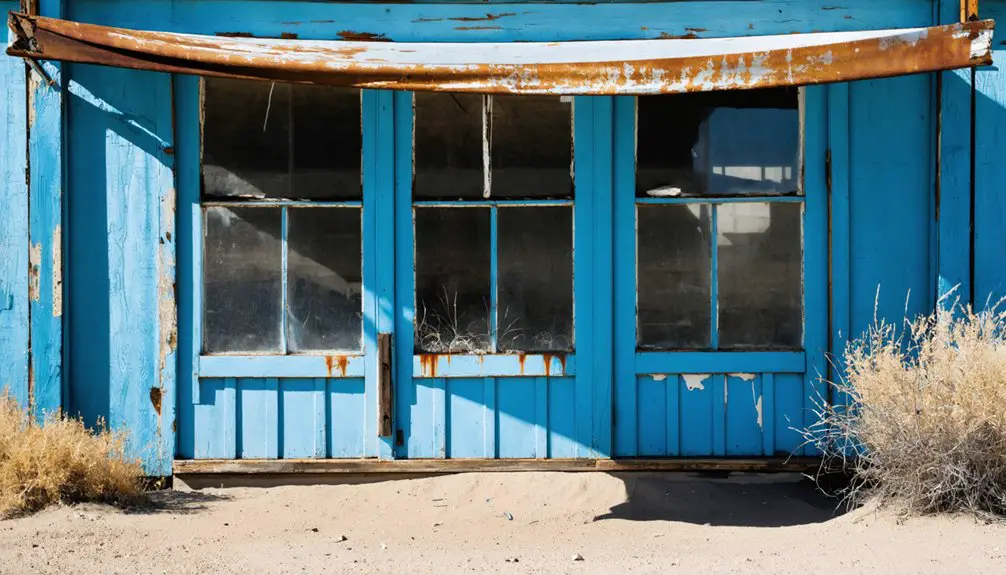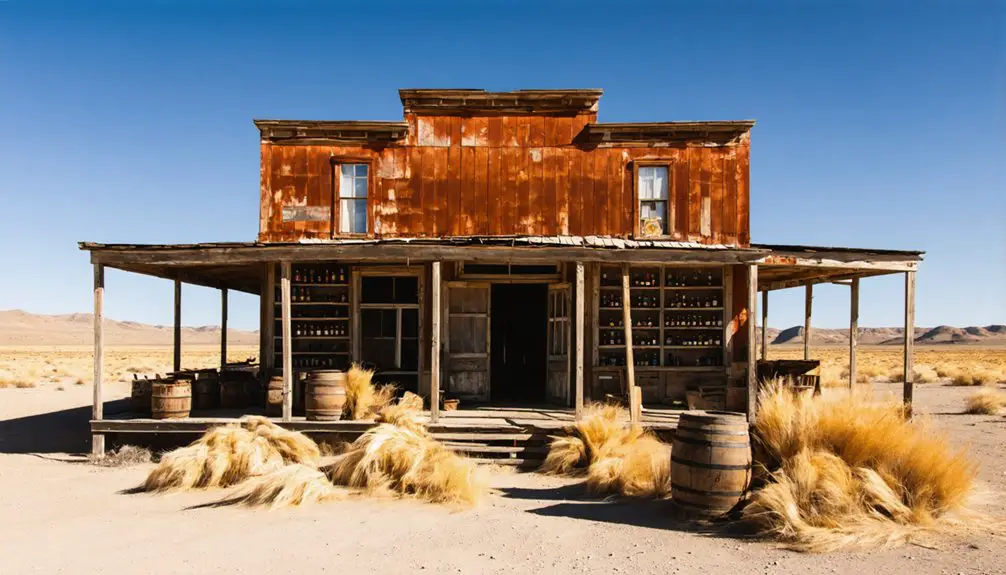You’ll find Clarkville’s remnants six miles northwest of Gallup, New Mexico, where this progressive coal mining town once flourished in the early 1900s. Unlike typical mining camps, it banned saloons and prioritized family-friendly amenities, including a hospital, school, and library. The Clark Coal Company’s planned community featured modern conveniences like electricity and telephone service. Though nature has reclaimed the site today, Clarkville’s unique story as a “dry” company town offers fascinating insights into New Mexico’s industrial past.
Key Takeaways
- Located six miles northwest of Gallup, New Mexico, Clarkville was a progressive coal mining town with no visible remains today.
- The town featured modern amenities including electricity, telephones, a hospital, school, library, and well-built houses.
- Unlike typical mining camps, Clarkville banned saloons and alcohol, creating a family-oriented community focused on social welfare.
- Nature has completely reclaimed the former townsite, with historical records being the primary source of information about its existence.
- The Clark Coal Company established the meticulously planned company town, which later thrived during the 1940s uranium boom.
A Coal Mining Oasis in McKinley County
While many mining towns of the early 1900s earned reputations as rough-and-tumble places, Clarkville stood apart as a particularly civilized settlement six miles northwest of Gallup. You’d find comfortable houses, a two-story brick commissary, and essential community buildings including a school, library, and hospital. The town even banned saloons and liquor sales, setting it apart from typical mining camps.
Despite economic disparities between wealthy eastern investors and the diverse immigrant labor force, Clarkville maintained modern amenities like telephone connections and an electrical plant powering a ten-ton locomotive. The town fell victim to the region’s mining decline, with its population halved by 1907. The closure of the post office in 1908 marked the beginning of Clarkville’s transition to ghost town status.
At its peak in 1905, nearly 400 residents called this coal mining oasis home. The town’s layout and facilities reflected a planned community that aimed to create stable living conditions amid the rugged terrain of McKinley County.
The Rise and Fall of a Mining Community
As the 1940s ushered in major uranium discoveries near Grants and expanded coal operations throughout McKinley County, Clarkville experienced unprecedented growth driven by government incentives and guaranteed ore prices.
You’ll find mining nostalgia in the remnants of this unique town that never had a saloon, where massive earth-moving equipment once extracted coal from depths reaching 2,700 feet. Unlike Kingston’s notorious reputation as one of the wildest towns in territorial New Mexico, Clarkville maintained a more reserved character. The town featured a two-storied commissary that supplied residents with all their daily necessities.
The economic transformation brought new infrastructure, including extensive railway networks for ore transport. Native American tribes, particularly the Navajo, secured employment through royalty agreements that boosted local development.
But like many mining towns, Clarkville’s fate was sealed by its dependence on a single industry. When the mines closed, the community couldn’t sustain itself, and the once-bustling town gradually faded into the landscape of New Mexico’s ghost towns.
Life in a Progressive Company Town
Unlike many rough-and-tumble mining settlements of its era, Clarkville stood out as a meticulously planned company town where progressive policies shaped daily life.
To avoid confusion with other towns sharing similar names, Clarkville was often referred to as the New Mexico settlement in historical records.
You’d find no rowdy saloons here – the town’s prohibition of liquor sales created a family-friendly atmosphere that set it apart from typical mining camps.
Just as Safer Way store founders lived in their Austin shop during early days, many Clarkville miners lived directly in company housing near their workplace.
Daily life centered around modern amenities that fostered community well-being. You could access educational programs at the school, browse books at the library, or seek care at the hospital.
The two-story brick commissary provided essential goods, while recreational activities flourished in this “pretty” town’s thoughtfully designed spaces.
Advanced infrastructure, including telephone lines and electric mining equipment, made work more efficient and safer.
This carefully crafted environment helped create a stable, content workforce unique to the American Southwest.
Social Culture and Community Values
You’ll find Clarkville’s most striking feature was its complete absence of saloons, setting it apart from typical mining settlements of the early 1900s where alcohol-centered entertainment dominated social life.
Instead of the usual mining camp revelry, you’d discover a community focused on educational facilities, healthcare access, and modern amenities like electricity and telephone service. This stark contrast to other mining towns like Lake Valley, where the Keller Miller store served as a central hub for goods worth millions, showed different approaches to community development.
The town’s history mirrored other New Mexico settlements like Dawson Coal Mine, which opened in 1901 and prioritized infrastructure development.
Within this carefully structured environment, miners and their families enjoyed comfortable housing and well-stocked mercantiles, reflecting the town’s commitment to orderly living standards rather than the rough-and-tumble atmosphere common to other coal camps.
No-Saloon Mining Town
The absence of saloons in Clarkville set it apart from virtually every other mining town in the American West. You wouldn’t have found the typical scenes of miners drowning their sorrows after a hard day’s work – instead, you’d have discovered a remarkably different social atmosphere.
The town’s strict alcohol prohibition fostered a unique environment where families thrived and community bonds formed around different focal points. Rather than gathering at a saloon, residents connected at the two-story brick commissary, the public library, and the local school. Similar to how James W. Virtue’s diary showed the prevalence of alcohol and gambling in other mining towns, Clarkville’s approach stood in stark contrast.
This deliberate policy created stronger social cohesion, with fewer alcohol-related disturbances than typical mining camps. The coal company and town leaders maintained these restrictions to guarantee worker productivity and safety, while simultaneously building a more stable, family-oriented community that residents genuinely appreciated.
Community Wellness First
While most mining towns prioritized quick profits over social stability, Clarkville’s founders built their community around wellness and family values. You’ll find their commitment to community engagement reflected in the town’s progressive health initiatives and social infrastructure that served a population of 400 residents in 1905. Unlike other settlements that focused heavily on stamp mills and saloons, Clarkville maintained a more balanced approach to development.
- A well-equipped hospital, school, and free public library formed the backbone of their social services.
- The absence of saloons and strict prohibition of liquor sales created a safer, more family-oriented environment.
- Modern amenities like electricity and telephone connections enhanced quality of life.
Unlike typical boom-and-bust mining camps, Clarkville’s focus on community wellness fostered contentment among residents. The comfortable homes, essential services, and emphasis on education created a sustainable community where miners and their families could truly thrive.
Orderly Living Standards
Despite its remote mining town status, Clarkville distinguished itself through carefully planned living standards that emphasized order, comfort, and social responsibility.
You’d find comfortably built houses and a pretty townscape that reflected residents’ pride in their community standards. The absence of saloons enforced orderly conduct and protected family values.
The town’s commitment to social welfare was evident in its modern amenities. You’d have access to a two-story brick commissary, public library, school, and hospital – institutions that fostered education and health.
The Clark Coal Company’s influence shaped a culture where sobriety and self-improvement mattered. With telephone connections and electric power linking the settlement, you’d experience a mining town that prioritized stability and resident well-being over the typical frontier vices.
Industrial Development and Power Systems
During the early 20th century, industrial development in Clarkville mirrored New Mexico’s broader mining expansion, marked by increasingly sophisticated earth-moving equipment and deeper mine shafts reaching 2,700 feet.
The town’s industrial infrastructure benefited from significant energy innovations as power systems evolved to support continuous mining operations.
You’ll find Clarkville’s development reflected these key industrial advances:
- A 65-mile railway network that connected mines to processing mills, enabling efficient mass transportation of resources
- Integration of modern power systems that supported both mining operations and emerging manufacturing facilities
- Pipeline infrastructure that facilitated the distribution of oil products, including gasoline and heating oil, strengthening the region’s industrial capabilities
These developments transformed Clarkville into a multi-industrial hub before its eventual decline.
Legacy and Physical Remnants Today

Today’s visitors to Clarkville’s former site will find little evidence of its once-bustling industrial operations.
You’ll encounter a landscape where nature has reclaimed what was once a thriving coal mining town of 400 residents. While historical records show Clarkville boasted impressive amenities – including a two-story commissary, hospital, library, and school – virtually no physical remnants remain visible at the location, situated about 5 miles northwest of Gallup.
Despite its physical disappearance, Clarkville’s historical significance endures through its unique characteristics.
Though its structures have vanished, Clarkville’s legacy as a distinctive mining settlement remains etched in New Mexico’s history.
You won’t find evidence of a saloon here – a distinctive feature that set it apart from typical mining towns. The site’s story lives on primarily through historical documentation, exemplifying the boom-bust cycles that shaped New Mexico’s early development in extractive industries.
Frequently Asked Questions
What Was the Average Wage of Coal Miners in Clarkville?
You’d find historical wages for surface miners were $5.60 per seven-hour day, while underground miners earned more, reflecting the economic impact of coal mining’s tiered pay structure.
Were There Any Major Mining Accidents or Deaths Recorded in Clarkville?
You won’t find any documented major mining accidents or deaths in the historical records, though local legends suggest the mine’s strict safety protocols and alcohol prohibition helped prevent disasters.
Which Mining Company Owned and Operated the Clarkville Coal Mine?
While many mining operations faced labor rights challenges in the early 1900s, Clark Coal Company, owned by W.A. Clark of Montana, operated this mine with advanced mining techniques through their subsidiary operations.
Did Native American Workers Participate in Clarkville’s Mining Operations?
While mining workforce diversity existed in New Mexico’s coal operations, you won’t find documented evidence of Native American contributions to Clarkville’s mines, despite their significant presence in later regional uranium mining.
What Happened to the Residents After They Left Clarkville?
When the wind blows, folks scatter. You’d find these former residents relocating to Gallup and other mining towns, with the community legacy dissolving as they sought new opportunities throughout the American Southwest.
References
- https://www.legendsofamerica.com/nm-mckinleycounty/
- https://www.ghosttowns.com/states/nm/clarkville.html
- https://www.youtube.com/watch?v=O_1iT_a-Wzw
- https://www.newmexico.org/places-to-visit/ghost-towns/
- https://www.arcadiapublishing.com/collections/marketplace/bisac-history-united-states-state-local-southwest-az-44-nm-44-ok-44-tx?page=17&phcursor=eyJhbGciOiJIUzI1NiJ9.eyJzayI6InByb2R1Y3RfbGluZV9pdGVtc19jb3VudCIsInN2IjoxLCJkIjoiYiIsInVpZCI6NDExNzc1MDExMzkyNDAsImwiOjM1LCJvIjowLCJyIjoiQ0RQIiwidiI6MX0.3y73wfWvwOfZ-pMWoRELfpcybLlD_Cimqkw-1rGFWa4
- https://www.visitgallup.com/blog/carbon-citys-coal-mining-legacy/
- https://online.nmartmuseum.org/nmhistory/growing-new-mexico/mining/history-mining.html
- https://pubs.usgs.gov/pp/0536c/report.pdf
- https://www.mininghistoryassociation.org/Journal/MHJ-v6-1999-Spude.pdf
- https://agmc.info/wp-content/uploads/simple-file-list/New-Mexico-documents/New_Mexico_Mining_History.pdf



